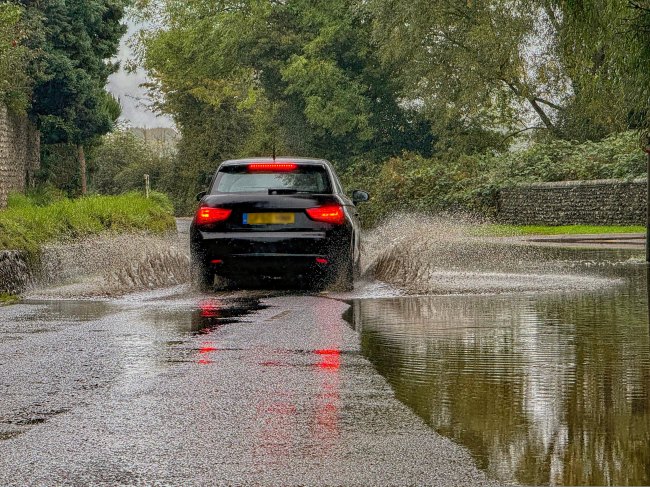Views
Storm Darragh: UK Water Companies Rise to the Challenge

As Storm Darragh swept across the UK between the 5th and 9th of December, bringing torrential rain, high winds nearing 100mph and a rare red weather warning issued by the Met Office, water companies faced one of their toughest challenges of the year. Despite the widespread disruption caused by the storm, which left hundreds of thousands of people across the UK and Ireland without power, the industry demonstrated strong resilience, ensuring almost all customers remained on mains water supply.
We all take for granted having our water supply on-tap for drinking, washing, cooking, cleaning, showering, and of course, using the loo. This blog highlights how UK water companies' preparedness, response, and recovery efforts during Storm Darragh kept water supply to homes, businesses, schools and hospitals intact.
Preparing for the Storm
Anticipating the severe weather conditions, UK water companies activated their comprehensive incident preparedness plans when the Met Office issued its weather alerts. These plans, refined through years of experience and continuous improvement, included:
- Enhanced monitoring and forecasting: Advanced meteorological tools were employed to track Storm Darragh's trajectory, enabling water companies to anticipate its effect on water and wastewater infrastructure.
- Proactive maintenance: Key assets, such as pumping stations, reservoirs, treatment works and power generation units, were inspected and fortified to withstand high winds and flooding.
- Staff and resource mobilisation: Additional field teams were deployed to high-risk areas, with equipment such as mobile generators, tankers, pumps, valves, etc. and materials pre-positioned to expedite repairs and minimise service disruptions.
- Coordination with stakeholders: Close collaboration with local authorities, emergency services, and power companies ensured a cohesive response to potential infrastructure challenges
- National Level Response: The water industry’s national incident management team, comprising representatives from all water and wastewater companies in the UK, was on standby just in case of emergency to support each other by sharing engineering equipment, alternative water supplies (e.g. bottled water, tankers, etc.) and specialised equipment. Thankfully this wasn’t needed.
Responding to the Challenges
Storm Darragh’s intensity tested the resilience of water and wastewater treatment sites, pumping stations, sewers and clean water networks across the country. Flooding, power outages, and debris damage posed significant challenges, but water companies acted swiftly to mitigate impacts:
- Rapid incident response: Field teams worked around the clock to repair damaged assets such us, burst water mains, clean water distribution centres and others and manage increased water use. Emergency tankers were deployed to maintain supplies in areas where localised interruptions occurred.
- Adaptable operations: Many water companies leveraged innovative technology, such as remote sensors and automated systems, to monitor network performance in real-time and respond to evolving conditions.
- Support for affected communities: Customer communication channels were boosted with dedicated teams providing real-time updates and advice to households experiencing temporary service issues.
Keeping on-demand supply for Customers
Despite the storm’s severity, water companies managed to keep almost all customers on supply - a testament to the sector’s robust infrastructure and proactive planning. This achievement was due to:
- Resilient design: Investments in flood defences, backup power systems, and network interconnectivity enabled the continued operation of critical facilities.
- Cross-sector support: Collaboration with other Critical National Infrastructure (CNI) sectors, particularly power and telecommunication companies, helped reduce disruption to the energy supply and communications with the sites that underpin water operations.
Recovery and Beyond
As the immediate threat of Storm Darragh subsided, water companies transitioned to the recovery phase. This included:
- Infrastructure assessments: Thorough inspections to identify and address any residual damage to water and wastewater systems.
- Lessons learned: Post-incident reviews to capture insights to refine further preparedness and response strategies for future events.
- Customer support: Ongoing engagement with affected communities to ensure that concerns are addressed and trust is reinforced.
Building Resilience for the Future
Storm Darragh occurred two weeks before Ofwat’s final determinations, which set how much companies can invest between 2025 and 2030. Resilience funding is of critical importance in safeguarding the UK’s water infrastructure, and as extreme weather events become more frequent and severe due to climate change, sustained investment is essential to fortify assets and enhance operational flexibility.
Storm Darragh also highlighted the interdependencies of critical national infrastructure sectors. Water companies depend heavily on reliable power supplies to operate treatment works and pump water to homes and businesses, and telecommunications to control assets and networks. Strengthening these interdependencies through coordinated planning and shared investment is crucial to building a more resilient future.
A Call to Action
The industry’s response to this event demonstrated the resilience and dedication of UK water companies, but it also reminded us of the challenges ahead. Policymakers, regulators, and stakeholders must continue to recognise the vital importance of investing in resilient infrastructure in the face of climate change and population growth, ensuring the water industry can continue to protect communities and the environment from the impacts of severe weather.




